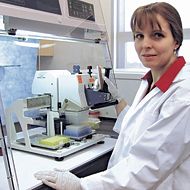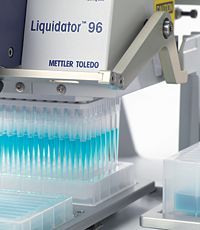
Housed in the Biodiversity Institute at the University of Guelph, in Toronto, the Canadian Centre for DNA Barcoding (CCDB) is an integral part of International Barcode of Life Project. The project is creating a barcode reference database of short standardized gene regions. Its mission: The identification and discovery of five million specimens from more than 500,000 species within five years.
The centre has processed roughly 300,000 animal, plant and fungal samples per year since 2009. Once at the CCDB, samples follow a typical genomics workflow with DNA extraction and PCR amplification. Downstream analysis methods include sequencing DNA barcodes for animals that comprise roughly 650 base pairs of COX gene. Chloroplast genes are used for plants, rbcL and matK.
 Suggested Solution Liquidator96
Suggested Solution Liquidator96
Speeding up the workflow using Liquidator 96 Dr. Natalia Ivanova, Lead DNA Scientist, explains how Rainin’s Liquidator 96 helps to speed up workflow in processing these DNA samples:
Dr. Natalia Ivanova, Lead DNA Scientist, explains how Rainin’s Liquidator 96 helps to speed up workflow in processing these DNA samples:
- “For the PCR and cycle sequencing setup, 2two µL of extracted DNA are added to a pre-made PCR plate or pre-made sequencing plates. Before we started using Liquidator 96, we used 8- or 12-channel pipettes for the transfer, which was much more laborious.“
- “Using the Liquidator has greatly improved pipetting accuracy and reduced the number of errors. Given that about 20-40 PCR plates are processed every day, Liquidator minimized the risk of wrist injury associated with repeated pipetting. The process of tip loading and unloading is quite easy, ergonomic and efficient.”
- “The Liquidator is a nice combination of robotic efficiency and the simplicity of manual handling. It does not require long or complicated training sessions (e.g. in comparison to liquid-handling robots). The learning curve was very quick and, after a single demo session, the whole lab started to use Liquidator.”
- “Liquidator provides direct time savings in up to 1.5 – 2 minutes per 96 well plate. With a high volume of processed samples labor cost savings can add up to over $5000 over a year. Indirect savings in labor and reagents that would be required to correct errors due to technician fatigue and human factor easily double or triple these cost savings. Liquidator has been a wise investment.”
 See the Liquidator 96 in action at CCDB
See the Liquidator 96 in action at CCDB Download the white paper: "CCDB Simplifies Genomic Workflow Liquidator 96 used in DNA Barcoding"
Download the white paper: "CCDB Simplifies Genomic Workflow Liquidator 96 used in DNA Barcoding"